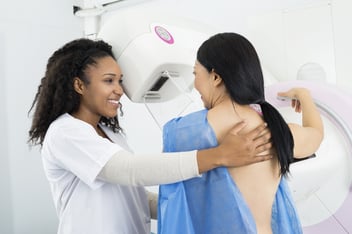Customer Success: Radiology Associates Help Improve Breast Cancer Care and Compliance
Background
Radiology Associates (RASLO) provides full-spectrum imaging and interventional radiology...

While compensation management is a challenge for many industries, practice leaders in the healthcare industry face unique complexities. Automatic deductions, on-call time tracking, floating labor distribution, shift differentials, and regulatory compliance are just a few of those complexities. If you add unique staffing models, company culture, subspecialties and several other factors into the mix, it is easy to see why taking a one-size-fits-all approach to measuring physician productivity and developing compensation management for radiology practices simply isn’t realistic.
I had the honor of joining Dr. Juan J. Jimenez, M.D., Associate Medical Director or Radiology at Carle Health and Clinical Associate Professor of Radiology at Carle-Illinois College of Medicine, for a presentation on this very topic at the 2022 ACR-RBMA Practice Leaders Forum earlier this year.
Making The Shift to Shift-Based Compensation
The title of our presentation may have been Making The Shift to Shift-Based Compensation, but Dr. Jimenez and I agreed that each practice leader needs to consider a number of factors, when measuring productivity and choosing the compensation model that works best for their practice.
Dr. Jimenez shared insights from his own hospital’s experience, as they transitioned from a productivity-based compensation model to a shift-based one. He walked us through several considerations including limitations, advantages, barriers and pitfalls of different compensation models and strategies to mitigate inequities in workload and compensation. In addition, he provided a great overview of the different compensation models, including individual production, pooled production and shift based.
Dr. Jimenez also emphasized the importance of data as part of any compensation model, including the following:
Changing The Way We Think About RVUs
That’s where I came in. I was excited to share real-world examples that demonstrate a lot of what Dr. Jimenez talked about, including what has worked for some of our clients and the challenges we have seen them face.
As I said earlier, there simply isn’t a single model that works best for every practice. Shift-based compensation offers advantages in some scenarios but may not be right for everyone. And while there may be some inherent flaws when it comes to RVU based physician compensation and productivity models, I believe they can serve as a launching pad to start building some robust analytics.
I think a good place to start is to think about RVUs a little differently. I recommend breaking apart the concept of a billing RVU and a productivity RVU, to really focus in on how practices can accurately capture the true value, including both the time and expertise, that is being spent from a provider vs. what is simply needed to get reimbursed from a health plan.
With that in mind, I believe practices should consider the following:
Understanding Provider Value
As Dr. Jimenez explained, there are a lot of variables to consider. It can get very complicated and complex very quickly. In my mind, that is not necessarily a bad thing. It just means that we, as an organization and an industry, need to put in place reports, analytics, and tools that allow providers to really get a sense of the value being provided while ensure that that compensation is fair and equitable.
When we are talking about developing those models, at some point we need to give that feedback back to both providers and management.
In terms of the provider, you may have followed best practices and determined how to set up your compensation model. Great! Now, you need to make sure your physicians have a clear understanding of how they are doing.
Giving providers access to the following can help them understand the value they are delivering:
All this data needs to be easy and simple for providers to access and understand. But they should also have access to a drill down of that data if necessary.
Giving Management What They Need
For management, you may have set up amazing reports and dashboards, but things change. CMS comes along. COVID comes along. Management needs to have visibility across your entire organization to understand the impact of these changes and quickly respond.
To achieve this, management should have access to not only a high-level overview, but also drill downs by:
Once again, back to the one-size doesn’t fit all premise, we should also think about having flexibility in how we deliver that data. Different people prefer to consume data in different ways. As leaders in this industry, we must be able to take complex information and serve it up not only in a simple format, but in different formats - tables, charts & graphs, quick mobile view, full-blown web platform, email/text notifications, etc.
Capturing Lost Productivity
It’s important to understand that not all productivity is measured in RVUs. Think admin time, tumor boards, academic time, E&M consults, etc. All that time is spent adding value to the practice but is not typically captured in RVUs or coming through a billing system. Without that data, there is no way to see the bigger picture.
Here are some categories of non RVU productivity that I believe every practice should be capturing and tracking:
Traditionally speaking, from a billing standpoint, these things are hard to capture. Fortunately, there is technology available to help.
Moving To The Forefront
I believe we are at a paradigm shift in healthcare when it comes to data and analytics. I think that we need to start taking data, analytics and reporting out of the background, stop limiting ourselves to static once-a-month reporting, and move that knowledge into the forefront to strategically tackle the issues ahead of us. Only then, can we understand how to:
I will be exploring the topic of compensation further at the upcoming RBMA Paradigm, as Anthony Werner and I present results from RBMA’s 2022 Compensation Survey (April 26th at 3:15 p.m.). I hope you will join us there! If you would like to schedule time at RBMA Paradigm to discuss any of this one-on-one, please let us know.

Background
Radiology Associates (RASLO) provides full-spectrum imaging and interventional radiology...

Healthcare Data Analytics Platform Poised to Help Anesthesiology Practices Drive Increased Revenue...

Helping Pathology Practice Leaders Respond to Growing Demand for Services with Reliable, Actionable...